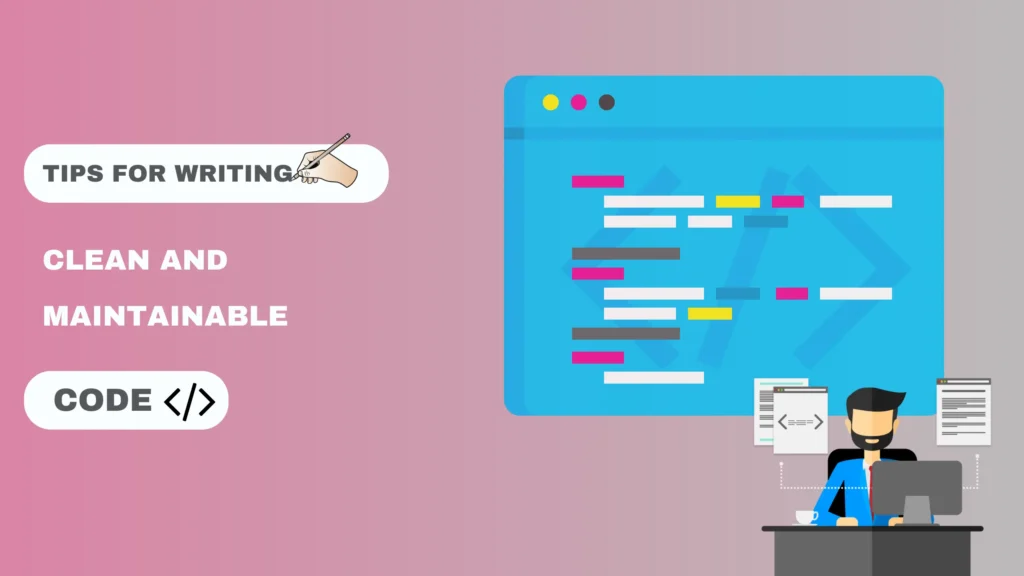Writing clean and maintainable code is essential for developers to develop efficient and reliable software. In this article we provide tips for how to write clean and maintainable code and it’s helpful for beginner and intermediate developers to make a coding journey efficiently.

1. Follow Consistent Naming Conventions
Using meaningful and descriptive names for variables, functions, and classes is essential for clarity and easy understanding of their rules for your teammates.
- Use Meaningful Names: Choose the names that show the purpose of the element. So avoid generic or Vague labels.
- Stick to a Standard Format: Stick to standard naming formats like camelCase, PascalCase, or another style to avoid confusion.
- Avoid Abbreviations and Cryptic Variables: Abbreviations save your time initially but not long-term. So avoid abbreviations and cryptic variables.
2. Keep Functions and Methods Short
Avoid using long complex functions and methods because it is the worst enemy for developers. Keep writing the functions and methods shortly it improves readability and makes debugging easier.
- Follow the Single Responsibility Principle: It says that a function should have one clear task. Ask, “Does this function do too much?” and break it down if necessary.
- Aim for One Clear Purpose: Each function should have a unique role. This approach simplifies the debugging and testing.
- Break Down Complex Logic: Split the complex logic into smaller, reusable functions. It improves readability and also encourages code reuse.
3. Write Self-Documenting Code
Self-documenting code is used to ensure clear and intuitive logic while reducing excessive comments, making the purpose immediately obvious.
- Use Clear and Intuitive Logic: Write a code that reads like a well-structured explanation.
- Minimize Excessive Comments: Use the comments only to clarify the complex logic.
- Structure Code for Readability: Organize your code logically for the understanding of your team.
4. Use Comments Wisely
Comments are used to identify the purpose of codes and it’s important to use them wisely.
- Explain Why, Not What: Comments should explain why something is done, not what is done.
- Remove Outdated Comments: Regularly update your comments to avoid confusion and maintain accuracy.
- Keep Comments Concise: Avoid targeted commands are lengthy explanations.
5. Follow DRY Principle
Follow the do not repeat yourself principle in writing the code because it helps to avoid errors and makes your codebase easier to maintain.
- Identify and Eliminate Redundant Codes: Find the duplicate codes remove them and follow the process regularly.
- Use Functions, Modules, or Classes: Reuse the codes through abstraction to avoid repetition.
- Avoid Unnecessary Duplication: Similar code blocks to create it single for easy maintenance.
6. Stick to a Consistent Code Formatting Style
Consistent code formatting improves readability and professionalism. And is easy to read and maintain. If anyone struggles to read your code because of inconsistent formatting, so avoid it. And make proper consistent formatting.
- Use Proper Indentation and Spacing: Using the proper indentation and spacing in your code makes understand code structure.
- Follow Established Style Guides: Follow style guides like PEP 8 for Python or the Google JavaScript Style Guide.
- Automate Formatting: Use tools like Prettier or ESLint to Automate formatting and free you to focus on writing code.
7. Implement Proper Error Handling
Effective error handling prevents silent failures and improves user experience. Use exceptions for handle the errors and provide meaningful error messages.
- Use Exceptions Effectively: Exceptions are used to handle the errors effectively that inform the user and maintain application flow.
- Avoid Silent Failures: Ensure that errors are logged or reported, preventing them from slipping unnoticed.
- Provide Meaningful Error Messages: Clear messages can reduce debugging time and improve user experience.
8. Use Version Control Effectively
Version control system likes Git are essential for managing code changes. It’s structuring your development process and supporting clean code.
- Follow Structured Commit Messages: Clear and informative commits make it easier to track the changes in code.
- Utilize Branches for Different Features: Branching keeps your main codebase stable while allowing experimentation.
- Document Repository Changes: Detailed logs help you trace the evolution of your project and resolve issues faster.
9. Write Unit Tests and Automate Testing
Unit tests ensure your code works as expected and catches issues early, ensuring that each part of your code performs as intended.
- Cover Key Functionalities with Unit Tests: Identify the critical parts of your application and test them thoroughly.
- Adopt Test-Driven Development (TDD): TDD encourages writing tests before code and guiding to a more modular design.
- Automate Testing: Automated tests catch the issues early and reduce manual testing time.
10. Document Your Code and Project Structure
Clear documentation is essential for new developers and maintaining your project. Good documentation ensures that everyone can understand and contribute effectively.
- Create Detailed Documentation for Functions and Modules: Explain the purpose, and parameters of the functions and modules for expected outcomes.
- Maintain a Comprehensive README File: Provide setup instructions and project insights to guide new developers.
- Utilize Documentation Tools: Use tools like JSDoc or Sphinx to document functions and modules.
Conclusion
By following these 10 best practices, you can create clean, maintainable, and efficient code with quality and professionalism. Whether you’re a beginner or an experienced developer, these strategies will help you write code that is easy to read, debug, and scale. Start implementing these practices today to take your coding skills to the next level!